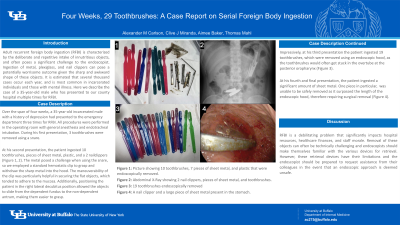Monday Poster Session
Category: General Endoscopy
P2426 - Four Weeks, 29 Toothbrushes: A Case Report on Serial Foreign Body Ingestion
Monday, October 28, 2024
10:30 AM - 4:00 PM ET
Location: Exhibit Hall E

Has Audio

Alexander M. Carlson, DO
University at Buffalo
Buffalo, NY
Presenting Author(s)
Alexander M. Carlson, DO1, Clive J. Miranda, DO, MSc2, Aimee Baker, RN1, Thomas Mahl, MD1
1University at Buffalo, Buffalo, NY; 2CHI Health Creighton University Medical Center, Omaha, NE
Introduction: Adult recurrent foreign body ingestion (RFBI) is characterized by the deliberate and repetitive intake of innutritious objects, and often poses a significant challenge to the endoscopist. Ingestion of metal, plexiglass, and nail clippers can pose a potentially worrisome outcome given the sharp and awkward shape of these objects. It is estimated that several thousand cases occur each year, and is most common in incarcerated individuals and those with mental illness. Here we describe the case of a 35-year-old male who has presented to our hospital multiple times for RFBI.
Case Description/Methods: Over the span of four weeks, a 35-year-old incarcerated male with a history of depression had presented to the emergency department three times for RFBI. All procedures were performed in the operating room with general anesthesia and endotracheal intubation. During his first presentation, 3 toothbrushes were removed using a snare.
At his second presentation, the patient ingested 10 toothbrushes, pieces of sharp metal, rigid plastic, and a 2 nailclippers (Figure 1, 2). The metal posed a challenge when using the snare, so we employed a standard hemostatic clip to grasp and withdraw the sharp metal into a latex hood. The maneuverability of the clip was particularly helpful in securing the flat objects, which tended to adhere to the mucosa. Additionally, positioning the patient in the right lateral decubitus position allowed the objects to slide from the dependent fundus to the non-dependent antrum, making them easier to grasp.
Impressively, at his third presentation the patient ingested 19 toothbrushes (Figure 3), which were removed using an endoscopic hood, as the toothbrushes would often get stuck in a overtube at the posterior oropharynx.
At his fourth and final presentation, the patient ingested a significant amount of sheet metal. One piece in particular was unable to be safely removed as it surpassed the length of the endoscopic hood, therefore requiring surgical removal (Figure 4).
Discussion: RFBI is a debilitating problem that significantly impacts hospital resources, healthcare finances, and staff morale. Removal of these objects can often be technically challenging and endoscopists should make themselves familiar with the various devices for retrieval. However, these retrieval devices have their limitations and the endoscopist should be prepared to request assistance from their colleagues in the event that an endoscopic approach is deemed unsafe.

Disclosures:
Alexander M. Carlson, DO1, Clive J. Miranda, DO, MSc2, Aimee Baker, RN1, Thomas Mahl, MD1. P2426 - Four Weeks, 29 Toothbrushes: A Case Report on Serial Foreign Body Ingestion, ACG 2024 Annual Scientific Meeting Abstracts. Philadelphia, PA: American College of Gastroenterology.
1University at Buffalo, Buffalo, NY; 2CHI Health Creighton University Medical Center, Omaha, NE
Introduction: Adult recurrent foreign body ingestion (RFBI) is characterized by the deliberate and repetitive intake of innutritious objects, and often poses a significant challenge to the endoscopist. Ingestion of metal, plexiglass, and nail clippers can pose a potentially worrisome outcome given the sharp and awkward shape of these objects. It is estimated that several thousand cases occur each year, and is most common in incarcerated individuals and those with mental illness. Here we describe the case of a 35-year-old male who has presented to our hospital multiple times for RFBI.
Case Description/Methods: Over the span of four weeks, a 35-year-old incarcerated male with a history of depression had presented to the emergency department three times for RFBI. All procedures were performed in the operating room with general anesthesia and endotracheal intubation. During his first presentation, 3 toothbrushes were removed using a snare.
At his second presentation, the patient ingested 10 toothbrushes, pieces of sharp metal, rigid plastic, and a 2 nailclippers (Figure 1, 2). The metal posed a challenge when using the snare, so we employed a standard hemostatic clip to grasp and withdraw the sharp metal into a latex hood. The maneuverability of the clip was particularly helpful in securing the flat objects, which tended to adhere to the mucosa. Additionally, positioning the patient in the right lateral decubitus position allowed the objects to slide from the dependent fundus to the non-dependent antrum, making them easier to grasp.
Impressively, at his third presentation the patient ingested 19 toothbrushes (Figure 3), which were removed using an endoscopic hood, as the toothbrushes would often get stuck in a overtube at the posterior oropharynx.
At his fourth and final presentation, the patient ingested a significant amount of sheet metal. One piece in particular was unable to be safely removed as it surpassed the length of the endoscopic hood, therefore requiring surgical removal (Figure 4).
Discussion: RFBI is a debilitating problem that significantly impacts hospital resources, healthcare finances, and staff morale. Removal of these objects can often be technically challenging and endoscopists should make themselves familiar with the various devices for retrieval. However, these retrieval devices have their limitations and the endoscopist should be prepared to request assistance from their colleagues in the event that an endoscopic approach is deemed unsafe.

Figure: Figure 1: Picture showing 10 toothbrushes, 7 pieces of sheet metal, and plastic that were endoscopically removed.
Figure 2: Abdominal X-Ray showing 2 nailclippers, pieces of sheet metal, and toothbrushes.
Figure 3: 19 toothbrushes endoscopically removed
Figure 4: A nail clipper and a large piece of sheet metal present in the stomach.
Figure 2: Abdominal X-Ray showing 2 nailclippers, pieces of sheet metal, and toothbrushes.
Figure 3: 19 toothbrushes endoscopically removed
Figure 4: A nail clipper and a large piece of sheet metal present in the stomach.
Disclosures:
Alexander Carlson indicated no relevant financial relationships.
Clive Miranda indicated no relevant financial relationships.
Aimee Baker indicated no relevant financial relationships.
Thomas Mahl indicated no relevant financial relationships.
Alexander M. Carlson, DO1, Clive J. Miranda, DO, MSc2, Aimee Baker, RN1, Thomas Mahl, MD1. P2426 - Four Weeks, 29 Toothbrushes: A Case Report on Serial Foreign Body Ingestion, ACG 2024 Annual Scientific Meeting Abstracts. Philadelphia, PA: American College of Gastroenterology.
